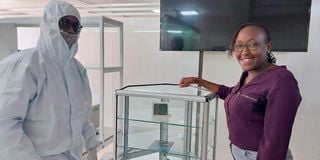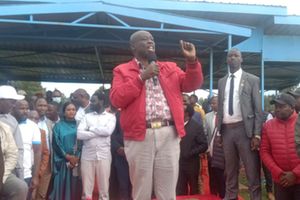Kenyan firm SayariLabs sends satellite to space in Indian rocket

Rose Wanjiku Njogu (right), an aerospace engineer who is the team lead at SayariLabs, a Nairobi-based startup that deals with space technology, with Isaac Malin, the onboard computer subsystem lead.
A piece of technology conceptualised and constructed in Nairobi was launched into space from India last Friday, a feat experts say takes Kenya closer to becoming an authority in space exploration.
The piece, roughly the size of a quarter of a foolscap, was part of a satellite assembled in the United States then shipped to India for the launch into space that happened via a rocket that left Satish Dhawan Space Centre on the morning of February 10. Think of it like the board inside a transistor radio where components that make the radio work are soldered together to align with a circuit.
The board sent to space is akin to that radio one, though it features high-tech processors and space-grade components all crammed into a small space. It was made to work inside a satellite called Janus-1, developed by an American company named Antaris. Now imagine a radio that allows many such boards to exist together in one enclosure. The Kenyan board was among seven – made by firms from seven different countries – that were incorporated in the Janus-1 satellite.
Makers of the board, who are based at a new office in Donholm, enclosed it in a locally made aluminium casing. The casing left room for cables to enable it to connect with the other components inside Janus-1. In the coming few days, the satellite will start functioning fully on low-earth orbit, about 450 kilometres above the earth’s surface. Then the Kenyan component and the others will start sending data to enable their various makers to carry out various tests.
Extreme temperatures
Makers of the component told the Nation that they want to especially see how it behaves under the extreme temperatures in its environment. Because it will be going around the earth, it will be swinging between very low and very hot temperatures—as low as -65°C when it is in some places and as high as 125 °C in others.
Ms Rose Wanjiku Njogu is the team leader of SayariLabs, the start-up that made the board. SayariLabs, one of the firms under Abxtract Venture Labs, works in partnership with the Kenya Space Agency (KSA).
In its team of 11, three are from KSA. KSA is a government body charged with promoting, coordinating and regulating space-related activities in the country.
“It is called the SayariLabs Payload Processor,” she said of the component.
“So, we got an opportunity with Antaris (the American firm). We partnered with them. They said they wanted to develop a software for space and they wanted to partner with different payload companies that can put a payload in space at a subsidised cost. We gave them our expression of interest in January 2022 and then we were approved in April of 2022. That is when we commenced the production of the board,” she added.
She and other engineers at SayariLabs scratched their heads to develop a component that would work with the software that Antaris was using. The American firm specialises in making software that powers satellites.
“The first step is to integrate with their software. But also, to develop the actual electrical board. So, you need to come up with a design,” said Ms Wanjiku, noting that the design phase involved thinking of the components like microchips, heat sensors, processors and the casing.
They had to write a code that would ensure the component works seamlessly with the others in the satellite because in space there is little room for error.
“You have to debug (eliminate processing errors) totally all the way to the end to make sure your product is almost bug-free,” she said. “There is no opportunity to get it back and debug.”
Ms Wanjiku, an alumna of Precious Blood Riruta, got her bachelor and master’s degrees from Embry-Riddle Aeronautical University in Florida, US. Using her expertise as an aerospace engineer, combined with the knowledge of the other SayariLabs members, she came up with the SayariLabs Payload Processor that was eventually accepted by Antaris. “[The board] also has communication capabilities, which means it can give us information on what is happening. Part of our mission with this board was to know the space environment,” she said.
Collect data
“We have never been there and we have never sent anything. And so we wanted to know: what are the temperatures it’s going to go through so it collects all the data? What are the functionalities it’s able to do? We had given it a few tasks for it to do: is it able to do it with all the crazy temperatures that are going on up there? Can it even survive launch? And so, those are the things we wanted to test out with our engineering and also validate whether we did our engineering well or we need to tweak a few things for the next mission,” added Ms Wanjiku.
So, have they started receiving the information from the component? Ms Wanjiku said there are processes to be executed before that happens.
“What happens when you launch a cubesat (cube satellite) is that it has to go through what is called tumbling and also commissioning. So, once it’s thrown out of the rocket that carries it to space – because essentially that’s what happens – it tumbles and then it is stabilised. Then, slowly, it opens its solar panels and starts charging the boards inside. So, it goes (round the earth) a few times, even for a week, to make sure everything is functional,” she explained.
“They were going to start commissioning each payload. So, our payload is part of those that were going to be commissioned. So, once it’s commissioned, then we start to receive data from it, and then we can use this data to validate: is it doing what it was supposed to do? We will send commands to it and see whether it’s functioning how we want it to function. And this is going to be done over the next year or two, to see how long our components are surviving in those harsh temperatures. So, once that is validated, then we can say, ‘Hey guys, we have a space-qualified module,’” added Ms Wanjiku.
A press release by Antaris, issued last Friday, confirmed that the satellite that contained the Kenyan-made component successfully reached orbit.
Satish Dhawan Space Centre
“Janus-1 rode on the Indian Space Research Organisation’s SSLV-D2 rocket, which was launched from the Satish Dhawan Space Centre of India under a commercial arrangement with New Space India Limited,” said the statement.
The presser added that the components in the satellite will be carrying out a number of tasks.
“(They) will perform internet of things communications, advanced experimental laser communications, radio communications and machine learning during orbit,” it noted.
SayariLabs, in conjunction with the space agency, have also been working on a complete cube satellite, called Taifa-1, that is expected to be launched into space in a month’s time. Taifa-1 will have a camera that will take photos when it flies above Kenya.
“It will only take pictures when it’s over Kenya. The camera will face towards the ground to take pictures. But when it passes Kenya, it will be tracking the sun to charge the solar panels; what is called sun-tracking,” Ms Wanjiku said.
“It’s going to be launching from California on the SpaceX.”
The ultimate goal of SayariLabs is to have a network of satellites orbiting the earth and helping Kenya gather information that can be useful for various fields like agriculture, forestry, border security, urban planning, among others. Kenya’s reliance on other countries for data, said the engineer, limits the type of information it can get. Having its own satellites can solve that problem, she noted.
“Once you start buying data from out there, then it becomes filtered, it is outdated,” said Ms Wanjiku.
“Taifa 1 is the beginning of what we are dubbing the Taifa series, which is basically a constellation of different satellites that are carrying different payloads to be able to provide as much data as we can for Kenya and for Africa,” she added.





